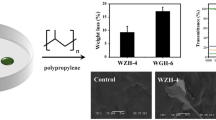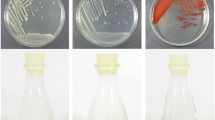Abstract
The phenol-degrading solvent-tolerant bacterium Pseudomonas putida P8 changed its cell shape when grown in the presence of aromatic compounds such as phenol and 4-chlorophenol. The sizes of cells that had been growing after addition of different concentrations of the toxic compounds were measured using a coulter counter that calculates the sizes of the rod-shaped bacteria to diameters of virtual spheres. The cells showed an increase in the diameter depending on the toxic effects of the applied concentrations of both solvents. The same effect was measured for an alkanol degrading bacterium, Enterobacter sp. VKGH12, in the presence of n-butanol. The reaction of the cells to different concentrations of n-butanol was examined by scanning electron microscopy. With this technique it could be shown that the size of the bacteria increased with increasing concentrations of n-butanol. These changes in cell size were dependent on the cellular activity and occurred only after addition of non-lethal concentrations. In the presence of lethal concentrations that completely inhibited cell growth, the cell sizes were similar to those of cells without intoxication. Taking into account the mathematical formula for spherical and cylindrical diameter and surface, respectively, the cells reacted to the presence of organic solvents by decreasing the ratio between surface and volume of the cells and therefore reducing their relative surfaces. As the cell surface and especially the cytoplasmic membrane are the major targets for the toxic effects of membrane-active compounds, this reduction of the relative surface represents an adaptive response to the presence of such compounds.




Similar content being viewed by others
References
Bettmann H, Rehm HJ (1984) Degradation of phenol by polymer entrapped microorganisms. Appl Microbiol Biotechnol 20:285–290
Chen Q, Janssen DB, Witholt B (1996) Physiological changes and alk gene instability in Pseudomonas oleovorans during induction and expression of alk genes. J Bacteriol 178:5508–5512
Daniel RA, Errington J (2003) Control of cell morphogenesis in bacteria: two distinct ways to make a rod-shaped cell. Cell 113:767–776
Diefenbach R, Keweloh H (1994) Synthesis of trans unsaturated fatty acids in Pseudomonas putida P8 by direct isomerization of the double bond of lipids. Arch Microbiol 162:120–125
Diefenbach R, Heipieper HJ, Keweloh H (1992) The conversion of cis- into trans- unsaturated fatty acids in Pseudomonas putida P8: evidence for a role in the regulation of membrane fluidity. Appl Microbiol Biotechnol 38:382–388
Givskov M, Eberl L, Moller S, Poulsen LK, Molin S (1994) Responses to nutrient starvation in Pseudomonas putida KT2442: analysis of general cross-protection, cell shape, and macromolecular content. J Bacteriol 176:7–14
Hartmans S, Smits JP, van der Werf MJ, Volkering F, de Bont JAM (1989) Metabolism of styrene oxide and 2-phenylethanol in the styrene-degrading Xanthobacter strain 124X. Appl Environ Microbiol 55:2850-2855
Heipieper HJ, Diefenbach R, Keweloh H (1992) Conversion of cis unsaturated fatty acids to trans, a possible mechanism for the protection of phenol-degrading Pseudomonas putida P8 from substrate toxicity. Appl Environ Microbiol 58:1847–1852
Heipieper HJ, Weber FJ, Sikkema J, Keweloh H, de Bont JAM (1994) Mechanisms behind resistance of whole cells to toxic organic solvents. Trends Biotechnol 12:409–415
Heipieper HJ, Loffeld B, Keweloh H, de Bont JAM (1995) The cis/trans isomerization of unsaturated fatty acids in Pseudomonas putida S12: an indicator for environmental stress due to organic compounds. Chemosphere 30:1041–1051
Heipieper HJ, Meinhardt F, Segura A (2003) The cis-trans isomerase of unsaturated fatty acids in Pseudomonas and Vibrio: biochemistry, molecular biology and physiological function of a unique stress adaptive mechanism. FEMS Microbiol Lett 229:1–7
Inoue A, Horikoshi K (1989) A Pseudomonas thrives in high concentrations of toluene. Nature 338:264–266
Isken S, de Bont JAM (1996) Active efflux of toluene in a solvent-resistant bacterium. J Bacteriol 178:6056–6058
Isken S, de Bont JAM (1998) Bacteria tolerant to organic solvents. Extremophiles 2:229–238
Isken S, Heipieper HJ (2002) Toxicity of organic solvents to microoganisms. In: Bitton G (ed) Encyclopedia of environmental microbiology. Wiley, New York, pp 3147–3155
Lewis K (1994) Multidrug resistance pumps in bacteria: variations on a theme. Trends Biochem Sci 19:119–123
Moller S, Pedersen AR, Poulsen LK, Arvin E, Molin S (1996) Activity and three-dimensional distribution of toluene-degrading Pseudomonas putida in a multispecies biofilm assessed by quantitative in situ hybridization and scanning confocal laser microscopy. Appl Environ Microbiol 62:4632–4640
Nikaido H (1994) Prevention of drug access to bacterial targets: permeability barriers and active efflux. Science 264:382–388
Pinkart HC, Wolfram JW, Rogers R, White DC (1996) Cell envelope changes in solvent-tolerant and solvent-sensitive Pseudomonas putida strains following exposure to o-xylene. Appl Environ Microbiol 62:1129–1132
Ramos JL, Duque E, RodriguezHerva JJ, Godoy P, Haidour A, Reyes F, FernandezBarrero A (1997) Mechanisms for solvent tolerance in bacteria. J Biol Chem 272:3887–3890
Ramos JL, Gallegos MT, Marques S, Ramos-Gonzalez MI, Espinosa-Urgel M, Segura A (2001) Responses of Gram-negative bacteria to certain environmental stressors. Curr Op Microbiol 4:166–171
Ramos JL, Duque E, Gallegos MT, Godoy P, Ramos-Gonzalez MI, Rojas A, Teran W, Segura A (2002) Mechanisms of solvent tolerance in gram-negative bacteria. Ann Rev Microbiol 56:743–768
Rasanen LA, Elvang AM, Jansson J, Lindstrom K (2001) Effect of heat stress on cell activity and cell morphology of the tropical rhizobium, Sinorhizobium arboris. FEMS Microbiol Ecol 34:267–278
Ritz M, Tholozan JL, Federighi M, Pilet MF (2001) Morphological and physiological characterization of Listeria monocytogenes subjected to high hydrostatic pressure. Appl Environ Microbiol 67:2240–2247
Rojas A, Duque E, Mosqueda G, Golden G, Hurtado A, Ramos JL, Segura A (2001) Three efflux pumps are required to provide efficient tolerance to toluene in Pseudomonas putida DOT-T1E. J Bacteriol 183:3967–3973
Segura A, Duque E, Mosqueda G, Ramos JL, Junker F (1999) Multiple responses of Gram-negative bacteria to organic solvents. Environ Microbiol 1:191–198
Shi BH, Xia XH (2003) Morphological changes of Pseudomonas pseudoalcaligenes in response to temperature selection. Curr Microbiol 46:120–123
Sikkema J, de Bont JA, Poolman B (1995) Mechanisms of membrane toxicity of hydrocarbons. Microbiol Rev 59:201–222
Young KD (2003) Bacterial shape. Mol Microbiol 49:571–580
Acknowledgements
This work was partially supported by Contract No. QLRT-2001-00435 of the European Commission within its Fifth Framework Programme. Özlem Sahin was funded by the German Academic Exchange Service (DAAD), reference number D/03/3146/1.
Author information
Authors and Affiliations
Corresponding author
Additional information
Communicated by K. Horikoshi
Rights and permissions
About this article
Cite this article
Neumann, G., Veeranagouda, Y., Karegoudar, T.B. et al. Cells of Pseudomonas putida and Enterobacter sp. adapt to toxic organic compounds by increasing their size. Extremophiles 9, 163–168 (2005). https://doi.org/10.1007/s00792-005-0431-x
Received:
Accepted:
Published:
Issue Date:
DOI: https://doi.org/10.1007/s00792-005-0431-x




